1.2 Research Strategies: How Psychologists Ask and Answer Questions
26
Psychologists arm their scientific attitude with the scientific method—a self-
The Scientific Method
1-
theory an explanation using an integrated set of principles that organizes observations and predicts behaviors or events.
In everyday conversation, we often use theory to mean “mere hunch.” Someone might, for example, discount evolution as “only a theory”—as if it were mere speculation. In science, a theory explains behaviors or events by offering ideas that organize what we have observed. By organizing isolated facts, a theory simplifies. By linking facts with deeper principles, a theory offers a useful summary. As we connect the observed dots, a coherent picture emerges.
A theory about the effects of sleep on memory, for example, helps us organize countless sleep-
hypothesis a testable prediction, often implied by a theory.
Yet no matter how reasonable a theory may sound—

 Figure 1.1
Figure 1.1The scientific method A self-
Our theories can bias our observations. Having theorized that better memory springs from more sleep, we may see what we expect: We may perceive sleepy people’s comments as less insightful. The urge to see what we expect is ever-
operational definition a carefully worded statement of the exact procedures (operations) used in a research study. For example, human intelligence may be operationally defined as what an intelligence test measures.
As a check on their biases, psychologists report their research with precise operational definitions of procedures and concepts. Sleep deprived, for example, may be defined as “X hours less” than the person’s natural sleep. Using these carefully worded statements, others can replicate (repeat) the original observations with different participants, materials, and circumstances. If they get similar results, confidence in the finding’s reliability grows. The first study of hindsight bias aroused psychologists’ curiosity. Now, after many successful replications with differing people and questions, we feel sure of the phenomenon’s power. Although a “mere replication” of someone else’s research seldom makes headline news, recent instances of fraudulent or hard-
replication repeating the essence of a research study, usually with different participants in different situations, to see whether the basic finding extends to other participants and circumstances.
27
In the end, our theory will be useful if it (1) organizes a range of self-
As we will see next, we can test our hypotheses and refine our theories using descriptive methods (which describe behaviors, often through case studies, surveys, or naturalistic observations), correlational methods (which associate different factors), and experimental methods (which manipulate factors to discover their effects). To think critically about popular psychology claims, we need to understand these methods and know what conclusions they allow.
RETRIEVAL PRACTICE
- What does a good theory do?
It organizes observed facts. 2. It implies hypotheses that offer testable predictions and, sometimes, practical applications. 3. It often stimulates further research.
- Why is replication important?
Psychologists watch eagerly for new findings, but they also proceed with caution—
Description
1-
The starting point of any science is description. In everyday life, we all observe and describe people, often drawing conclusions about why they act as they do. Professional psychologists do much the same, though more objectively and systematically, through
28
- case studies (in-depth analyses of individuals or groups).
- naturalistic observations (watching and recording the natural behavior of many individuals).
- surveys and interviews (asking people questions).
The Case Study
“‘Well my dear,’ said Miss Marple, ‘human nature is very much the same everywhere, and of course, one has opportunities of observing it at closer quarters in a village’.”
Agatha Christie, The Tuesday Club Murders, 1933
Among the oldest research methods, the case study examines one individual or group in depth in the hope of revealing things true of us all. Some examples: Much of our early knowledge about the brain came from case studies of individuals who suffered a particular impairment after damage to a certain brain region. Jean Piaget taught us about children’s thinking after carefully observing and questioning only a few children. Studies of only a few chimpanzees have revealed their capacity for understanding and language. Intensive case studies are sometimes very revealing. They show us what can happen, and they often suggest directions for further study.

But atypical individual cases may mislead us. Unrepresentative information can lead to mistaken judgments and false conclusions. Indeed, anytime a researcher mentions a finding (Smokers die younger: 95 percent of men over 85 are nonsmokers) someone is sure to offer a contradictory anecdote (Well, I have an uncle who smoked two packs a day and lived to be 89). Dramatic stories and personal experiences (even psychological case examples) command our attention and are easily remembered. Journalists understand that, and often begin their articles with personal stories. Stories move us. But stories can mislead. Which of the following do you find more memorable? (1) “In one study of 1300 dream reports concerning a kidnapped child, only 5 percent correctly envisioned the child as dead” (Murray & Wheeler, 1937). (2) “I know a man who dreamed his sister was in a car accident, and two days later she died in a head-
case study a descriptive technique in which one individual or group is studied in depth in the hope of revealing universal principles.
The point to remember: Individual cases can suggest fruitful ideas. What’s true of all of us can be glimpsed in any one of us. But to discern the general truths that cover individual cases, we must answer questions with other research methods.
RETRIEVAL PRACTICE
- We cannot assume that case studies always reveal general principles that apply to all of us. Why not?
Case studies involve only one individual or group, so we can’t know for sure whether the principles observed would apply to a larger population.
Naturalistic Observation
naturalistic observation a descriptive technique of observing and recording behavior in naturally occurring situations without trying to manipulate and control the situation.
A second descriptive method records behavior in natural environments. These naturalistic observations range from watching chimpanzee societies in the jungle, to videotaping and analyzing parent-
Naturalistic observation has mostly been “small science”—science that can be done with pen and paper rather than fancy equipment and a big budget (Provine, 2012). But new technologies are enabling “big data” observations. New smart-
29
Another research team studied the ups and downs of human moods by counting positive and negative words in 504 million Twitter messages from 84 countries (Golder & Macy, 2011). As FIGURE 1.2 shows, people seem happier on weekends, shortly after arising, and in the evenings. (Are late Saturday evenings often a happy time for you, too?)
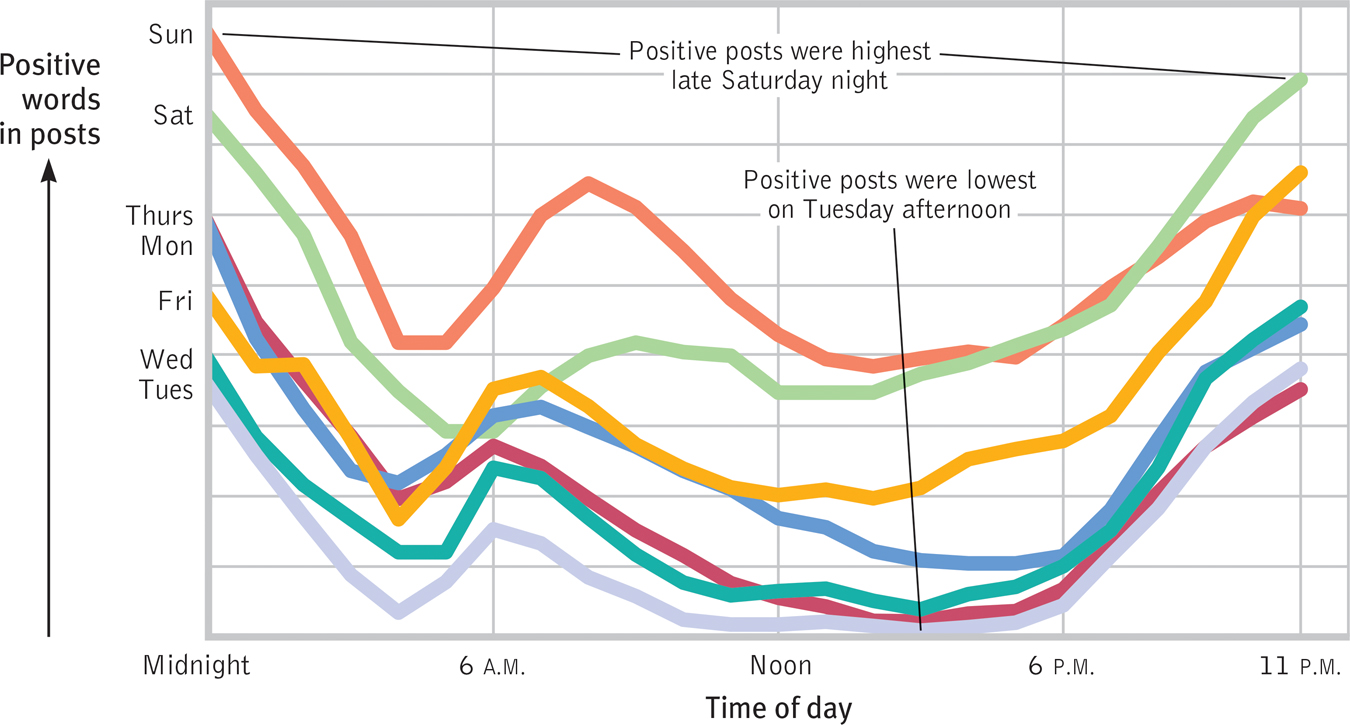
 Figure 1.2
Figure 1.2Twitter message moods, by time and by day This illustrates how, without knowing anyone’s identity, big data enable researchers to study human behavior on a massive scale. It now is also possible to associate people’s moods with, for example, their locations or with the weather, and to study the spread of ideas through social networks. (Data from Golder & Macy, 2011.)
Like the case study, naturalistic observation does not explain behavior. It describes it. Nevertheless, descriptions can be revealing. We once thought, for example, that only humans use tools. Then naturalistic observation revealed that chimpanzees sometimes insert a stick in a termite mound and withdraw it, eating the stick’s load of termites. Such unobtrusive naturalistic observations paved the way for later studies of animal thinking, language, and emotion, which further expanded our understanding of our fellow animals. “Observations, made in the natural habitat, helped to show that the societies and behavior of animals are far more complex than previously supposed,” chimpanzee observer Jane Goodall noted (1998). Thanks to researchers’ observations, we know that chimpanzees and baboons use deception: Psychologists repeatedly saw one young baboon pretending to have been attacked by another as a tactic to get its mother to drive the other baboon away from its food (Whiten & Byrne, 1988).

Naturalistic observations also illuminate human behavior. Here are four findings you might enjoy:
- A funny finding. We humans laugh 30 times more often in social situations than in solitary situations. (Have you noticed how seldom you laugh when alone?) As we laugh, 17 muscles contort our mouth and squeeze our eyes, and we emit a series of 75-millisecond vowel-like sounds, spaced about one-fifth of a second apart (Provine, 2001).
- Sounding out students. What, really, are introductory psychology students saying and doing during their everyday lives? To find out, Matthias Mehl and James Pennebaker (2003) equipped 52 such students from the University of Texas with electronic recorders. For up to four days, the recorders captured 30 seconds of the students’ waking hours every 12.5 minutes, thus enabling the researchers to eavesdrop on more than 10,000 half-minute life slices by the end of the study. On what percentage of the slices do you suppose they found the students talking with someone? What percentage captured the students at a computer? The answers: 28 and 9 percent. (What percentage of your waking hours are spent in these activities?)
- What’s on your mind? To find out what was on the minds of their University of Nevada, Las Vegas, students, Christopher Heavey and Russell Hurlburt (2008) gave them beepers. On a half-dozen occasions, a beep interrupted students’ daily activities, signaling them to pull out a notebook and record their inner experience at that moment. When the researchers later coded the reports in categories, they found five common forms of inner experience (TABLE 1.1).
- Culture, climate, and the pace of life. Naturalistic observation also enabled Robert Levine and Ara Norenzayan (1999) to compare the pace of life in 31 countries. (Their operational definition of pace of life included walking speed, the speed with which postal clerks completed a simple request, and the accuracy of public clocks.) Their conclusion: Life is fastest paced in Japan and Western Europe, and slower paced in economically less-developed countries. People in colder climates also tend to live at a faster pace (and are more prone to die from heart disease).
30
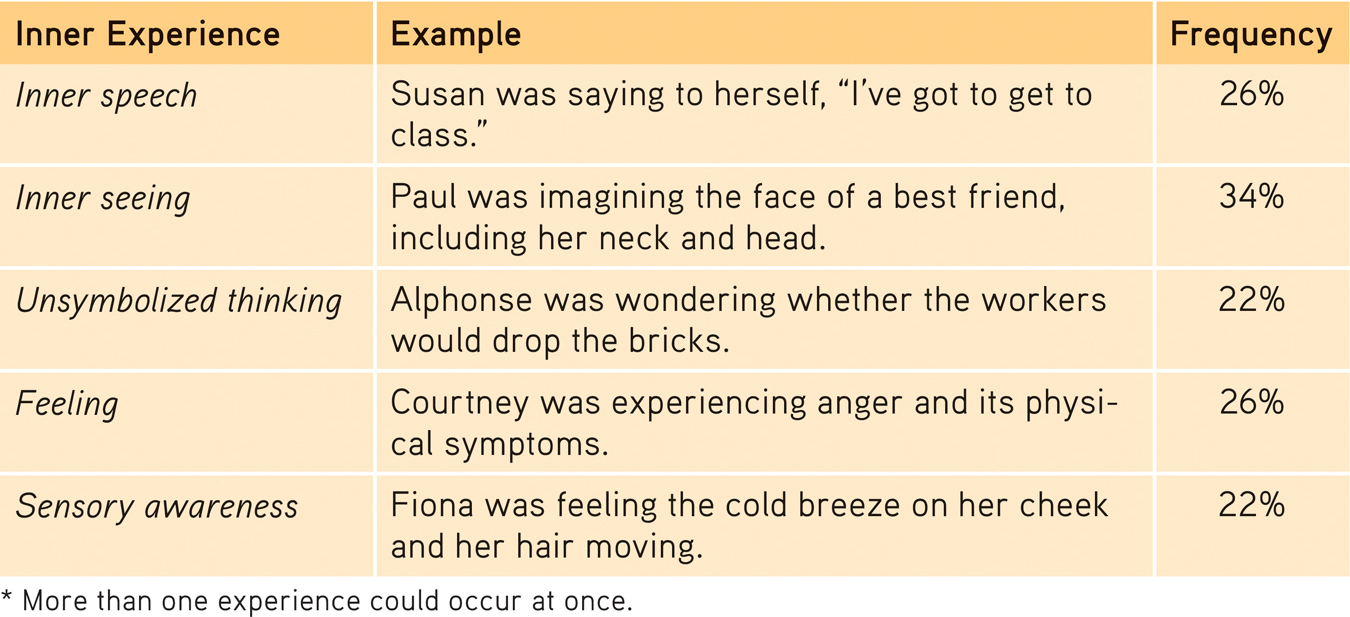
 Table 1.1
Table 1.1A Penny for Your Thoughts: The Inner Experience of University Students)
Naturalistic observation offers interesting snapshots of everyday life, but it does so without controlling for all the factors that may influence behavior. It’s one thing to observe the pace of life in various places, but another to understand what makes some people walk faster than others.
RETRIEVAL PRACTICE
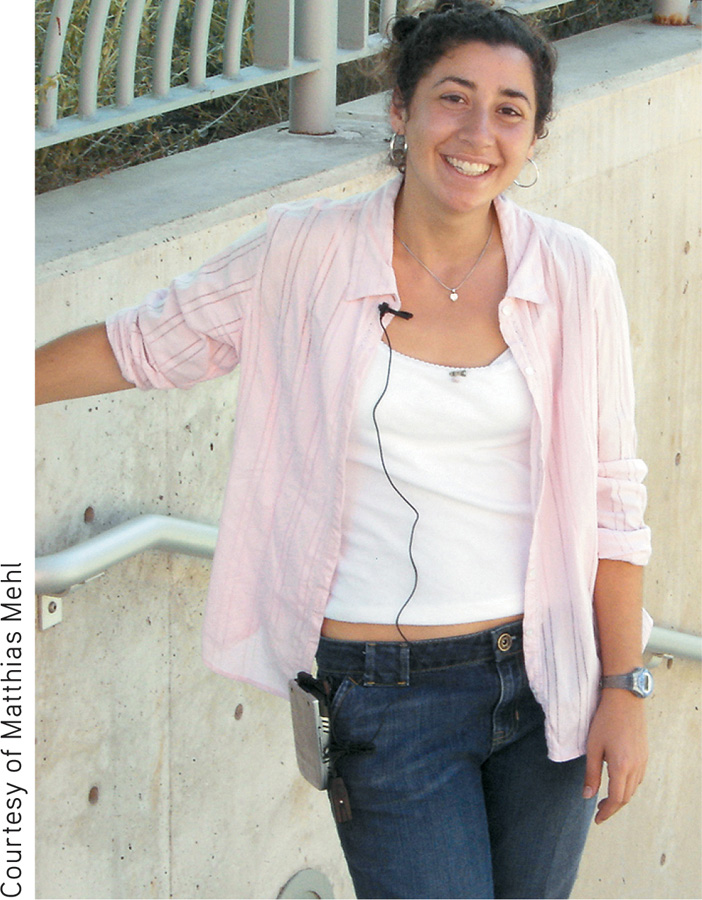
- What are the advantages and disadvantages of naturalistic observation, such as Mehl and Pennebaker used in this study?
The researchers were able to carefully observe and record naturally occurring behaviors outside the artificiality of the lab. However, outside the lab they were not able to control for all the factors that may have influenced the everyday interactions they were recording.
The Survey
A survey looks at many cases in less depth. A survey asks people to report their behavior or opinions. Questions about everything from sexual practices to political opinions are put to the public. In recent surveys:
- Saturdays and Sundays have been the week’s happiest days (confirming what the Twitter researchers found) (Stone et al., 2012).
- 1 in 5 people across 22 countries report believing that alien beings have come to Earth and now walk among us disguised as humans (Ipsos, 2010b).
- 68 percent of all humans—some 4.6 billion people—say that religion is important in their daily lives (from Gallup World Poll data analyzed by Diener et al., 2011).
survey a descriptive technique for obtaining the self-reported attitudes or behaviors of a particular group, usually by questioning a representative, random sample of the group.
But asking questions is tricky, and the answers often depend on how questions are worded and respondents are chosen.
31
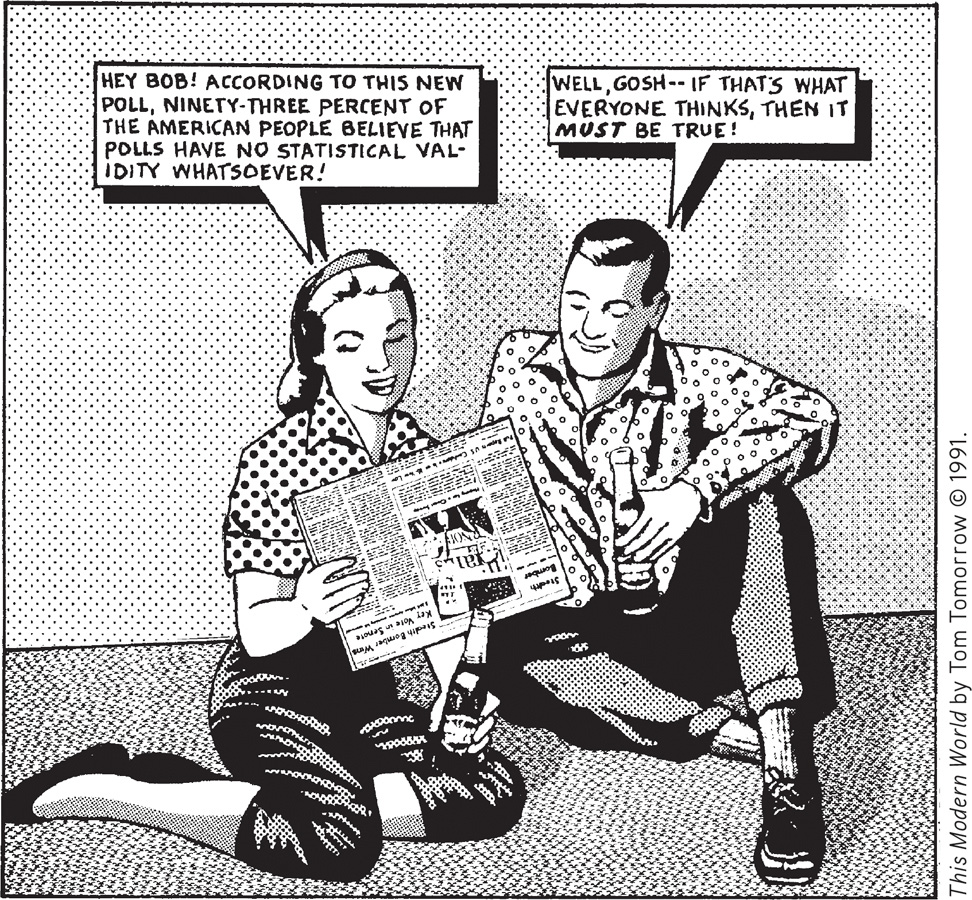
Wording Effects Even subtle changes in the order or wording of questions can have major effects. People are much more approving of “aid to the needy” than of “welfare,” of “affirmative action” than of “preferential treatment,” of “not allowing” televised cigarette ads and pornography than of “censoring” them, and of “revenue enhancers” than of “taxes.” In another survey, adults estimated a 55 percent chance “that I will live to be 85 years old or older,” while comparable other adults estimated a 68 percent chance “that I will die at 85 years old or younger” (Payne et al., 2013). Because wording is such a delicate matter, critical thinkers will reflect on how the phrasing of a question might affect people’s expressed opinions.
Random SamplingIn everyday thinking, we tend to generalize from samples we observe, especially vivid cases. Given (a) a statistical summary of a professor’s student evaluations and (b) the vivid comments of a biased sample (two irate students), an administrator’s impression of the professor may be influenced as much by the two unhappy students as by the many favorable evaluations in the statistical summary. The temptation to ignore the sampling bias and to generalize from a few vivid but unrepresentative cases is nearly irresistible.
population all those in a group being studied, from which samples may be drawn. (Note: Except for national studies, this does not refer to a country’s whole population.)
So how do you obtain a representative sample of, say, the students at your college or university? It’s not always possible to survey the whole group you want to study and describe. How could you choose a group that would represent the total student population? Typically, you would seek a random sample, in which every person in the entire group has an equal chance of participating. You might number the names in the general student listing and then use a random number generator to pick your survey participants. (Sending each student a questionnaire wouldn’t work because the conscientious people who returned it would not be a random sample.) Large representative samples are better than small ones, but a small representative sample of 100 is better than an unrepresentative sample of 500.
random sample a sample that fairly represents a population because each member has an equal chance of inclusion.
With very large samples, estimates become quite reliable. E is estimated to represent 12.7 percent of the letters in written English. E, in fact, is 12.3 percent of the 925,141 letters in Melville’s Moby-Dick, 12.4 percent of the 586,747 letters in Dickens’ A Tale of Two Cities, and 12.1 percent of the 3,901,021 letters in 12 of Mark Twain’s works (Chance News, 1997).
Political pollsters sample voters in national election surveys just this way. Using some 1500 randomly sampled people, drawn from all areas of a country, they can provide a remarkably accurate snapshot of the nation’s opinions. Without random sampling, large samples—
The point to remember: Before accepting survey findings, think critically. Consider the sample. The best basis for generalizing is from a representative sample. You cannot compensate for an unrepresentative sample by simply adding more people.
RETRIEVAL PRACTICE
- What is an unrepresentative sample, and how do researchers avoid it?
An unrepresentative sample is a survey group that does not represent the population being studied. Random sampling helps researchers form a representative sample, because each member of the population has an equal chance of being included.
Correlation
1-
correlation a measure of the extent to which two factors vary together, and thus of how well either factor predicts the other.
Describing behavior is a first step toward predicting it. Naturalistic observations and surveys often show us that one trait or behavior is related to another. In such cases, we say the two correlate. A statistical measure (the correlation coefficient) helps us figure how closely two things vary together, and thus how well either one predicts the other. Knowing how much aptitude test scores correlate with school success tells us how well the scores predict school success.
correlation coefficient a statistical index of the relationship between two things (from −1.00 to +1.00).
scatterplot a graphed cluster of dots, each of which represents the values of two variables. The slope of the points suggests the direction of the relationship between the two variables. The amount of scatter suggests the strength of the correlation (little scatter indicates high correlation).
Throughout this book, we will often ask how strongly two things are related: For example, how closely related are the personality scores of identical twins? How well do intelligence test scores predict career achievement? How closely is stress related to disease? In such cases, scatterplots can be very revealing.
32
Each dot in a scatterplot represents the values of two variables. The three scatterplots in FIGURE 1.3 illustrate the range of possible correlations from a perfect positive to a perfect negative. (Perfect correlations rarely occur in the real world.) A correlation is positive if two sets of scores, such as height and weight, tend to rise or fall together.

 Figure 1.3
Figure 1.3Scatterplots, showing patterns of correlation Correlations can range from +1.00 (scores on one measure increase in direct proportion to scores on another), to 0.00 (no relationship), to –1.00 (scores on one measure decrease precisely as scores rise on the other).
Saying that a correlation is “negative” says nothing about its strength. A correlation is negative if two sets of scores relate inversely, one set going up as the other goes down. The study of University of Nevada students discussed earlier found their reports of inner speech correlated negatively (−.36) with their reported psychological distress. Those who reported more inner speech tended to report somewhat less psychological distress.
Statistics can help us see what the naked eye sometimes misses. To demonstrate this for yourself, try an imaginary project. You wonder if tall men are more or less easygoing, so you collect two sets of scores: men’s heights and men’s temperaments. You measure the heights of 20 men, and you have someone else independently assess their temperaments from 0 (extremely calm) to 100 (highly reactive).
With all the relevant data right in front of you (TABLE 1.2), can you tell whether the correlation between height and reactive temperament is positive, negative, or close to zero?
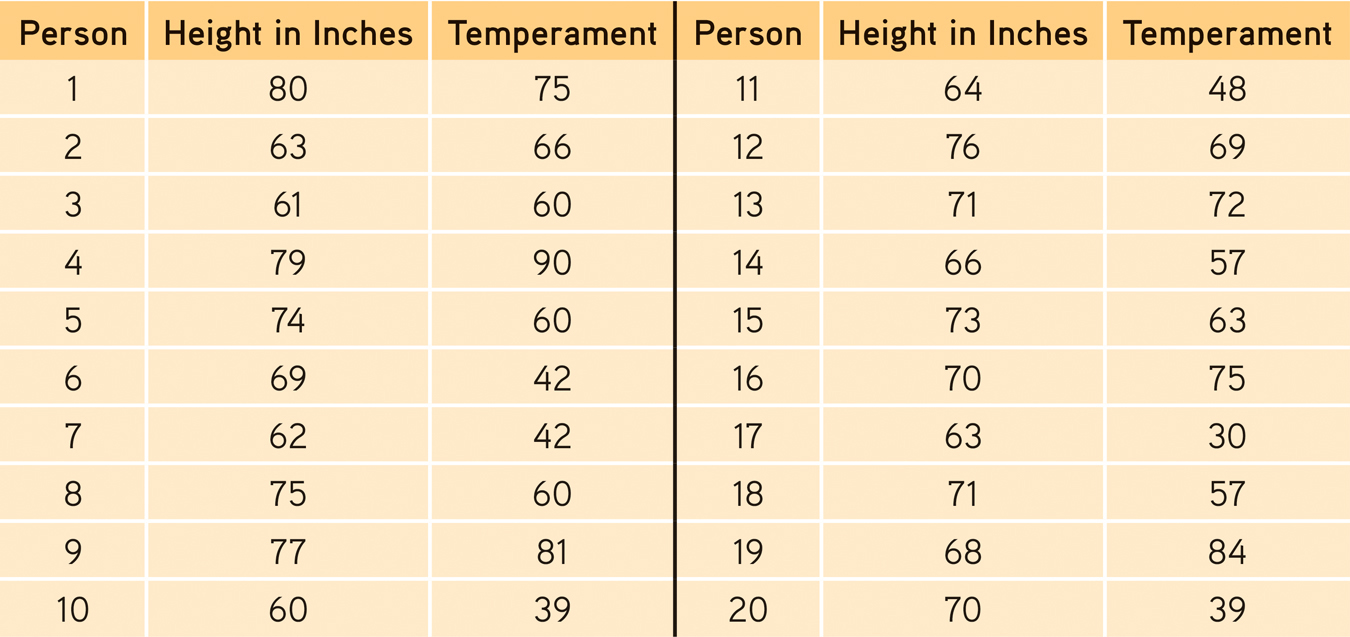
 Table 1.2
Table 1.2Height and Temperamental Reactivity of 20 Men
Comparing the columns in TABLE 1.2, most people detect very little relationship between height and temperament. In fact, the correlation in this imaginary example is positive, +.63, as we can see if we display the data as a scatterplot (FIGURE 1.4).
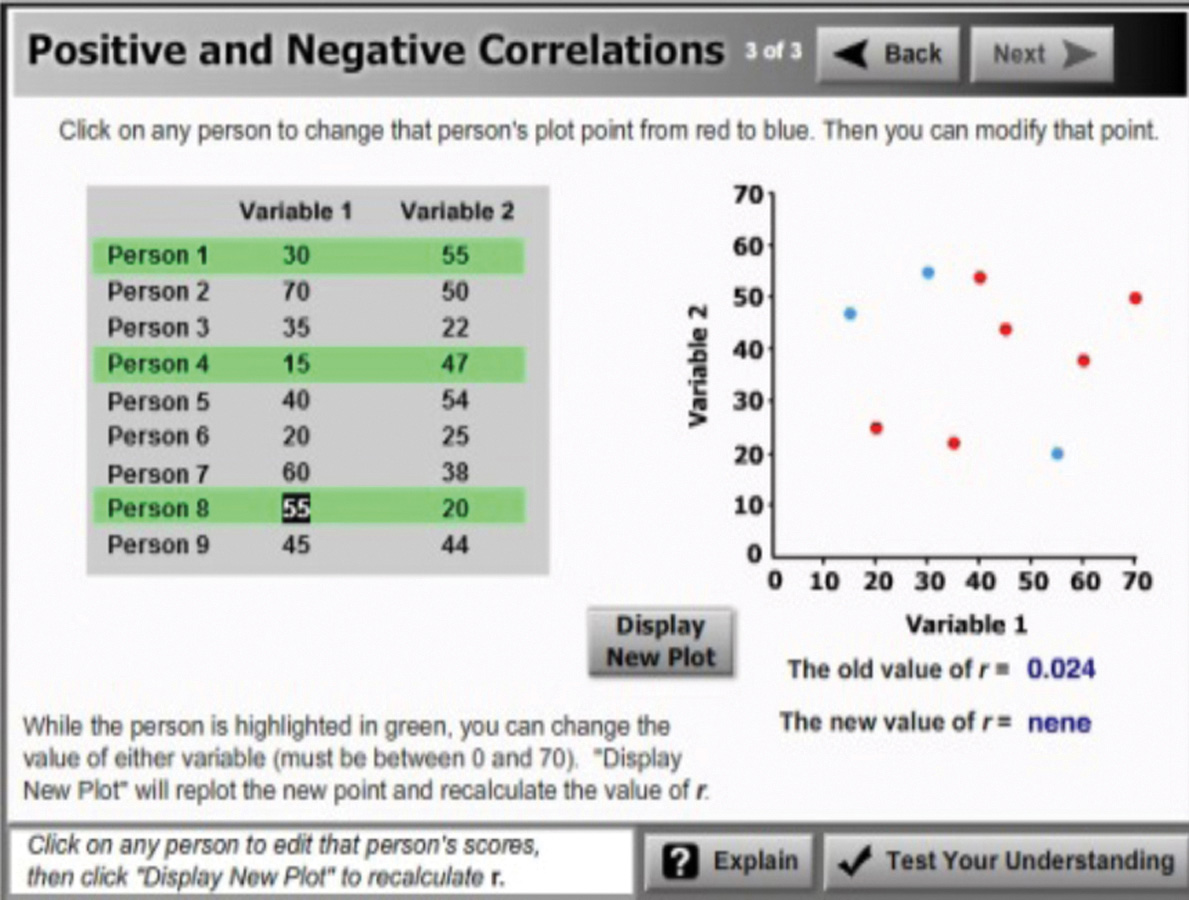
 For an animated tutorial on correlations, visit LaunchPad’s Concept Practice: Positive and Negative Correlations.
For an animated tutorial on correlations, visit LaunchPad’s Concept Practice: Positive and Negative Correlations.
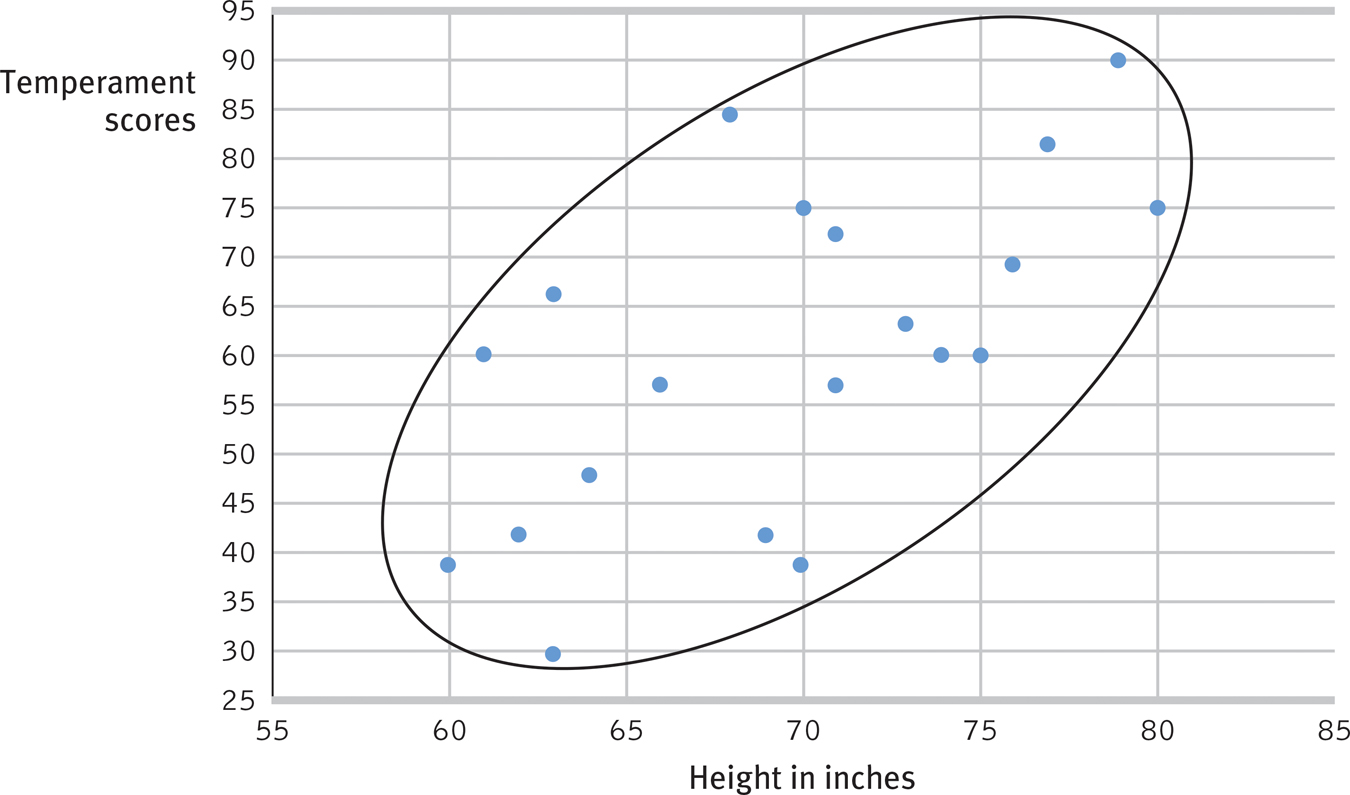
 Figure 1.4
Figure 1.4Scatterplot for height and reactive temperament This display of data from 20 imagined people (each represented by a data point) reveals an upward slope, indicating a positive correlation. The considerable scatter of the data indicates the correlation is much lower than +1.00.
If we fail to see a relationship when data are presented as systematically as in TABLE 1.2, how much less likely are we to notice them in everyday life? To see what is right in front of us, we sometimes need statistical illumination. We can easily see evidence of gender discrimination when given statistically summarized information about job level, seniority, performance, gender, and salary. But we often see no discrimination when the same information dribbles in, case by case (Twiss et al., 1989).
The point to remember: A correlation coefficient helps us see the world more clearly by revealing the extent to which two things relate.
33
RETRIEVAL PRACTICE
- Indicate whether each association is a positive correlation or a negative correlation.
- The more children and youth used various media, the less happy they were with their lives (Kaiser, 2010). ______________
- The less sexual content teens saw on TV, the less likely they were to have sex (Collins et al., 2004). ______________
- The longer children were breast-fed, the greater their later academic achievement (Horwood & Ferguson, 1998). ______________
- The more income rose among a sample of poor families, the fewer psychiatric symptoms their children experienced (Costello et al., 2003). ______________
1. negative, 2. positive, 3. positive, 4. negative
Regression Toward the Mean
1-
Correlations not only make visible the relationships we might otherwise miss, they also restrain our “seeing” nonexistent relationships. When we believe there is a relationship between two things, we are likely to notice and recall instances that confirm our belief. If we believe that dreams are forecasts of actual events, we may notice and recall confirming instances more than disconfirming instances. The result is an illusory correlation.
regression toward the mean the tendency for extreme or unusual scores or events to fall back (regress) toward the average.
Illusory correlations feed an illusion of control—
The point may seem obvious, yet we regularly miss it: We sometimes attribute what may be a normal regression (the expected return to normal) to something we have done. Consider two examples:
- Students who score much lower or higher on an exam than they usually do are likely, when retested, to return to their average.
- Unusual ESP subjects who defy chance when first tested nearly always lose their “psychic powers” when retested (a phenomenon parapsychologists have called the decline effect).
34
Failure to recognize regression is the source of many superstitions and of some ineffective practices as well. When day-
“Once you become sensitized to it, you see regression everywhere.”
Psychologist Daniel Kahneman (1985)
The point to remember: When a fluctuating behavior returns to normal, there is no need to invent fancy explanations for why it does so. Regression toward the mean is probably at work.
RETRIEVAL PRACTICE
- You hear the school basketball coach telling her friend that she rescued her team’s winning streak by yelling at the players after an unusually bad first half. What is another explanation of why the team’s performance improved?
The team’s poor performance was not their typical behavior. Their return to their normal—
Correlation and Causation
1-
Consider some recent newsworthy correlations:
- “Study finds that increased parental support for college results in lower grades” (Jaschik, 2013).
- People with mental illness more likely to be smokers, study finds” (Belluck, 2013).
- “Teens who play mature-rated, risk-glorifying video games [tend] to become reckless drivers” (Bowen, 2012).
What shall we make of these correlations? Do they indicate that students would achieve more if their parents would support them less? That stopping smoking would improve mental health? That abstaining from video games would make reckless teen drivers more responsible?
No, because such correlations do not come with built-
RETRIEVAL PRACTICE

- Length of marriage positively correlates with hair loss in men. Does this mean that marriage causes men to lose their hair (or that balding men make better husbands)?
In this case, as in many others, a third factor can explain the correlation: Golden anniversaries and baldness both accompany aging.
Another example: Self-
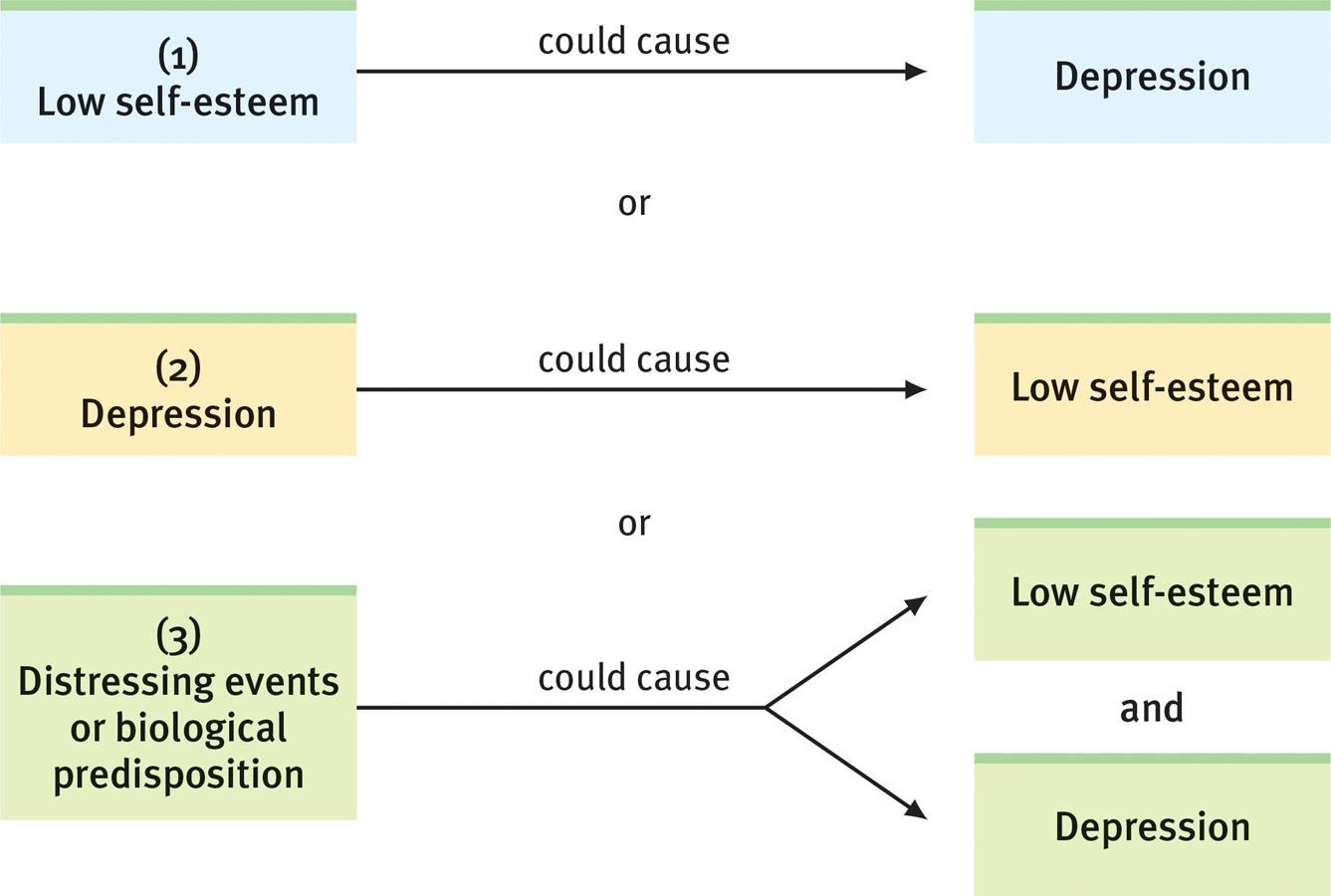
 Figure 1.5
Figure 1.5Three possible cause-
This point is so important—
35
The point to remember (turn the volume up here): Correlation does not prove causation.3 Correlation indicates the possibility of a cause-
Experimentation
1-
Happy are they, remarked the Roman poet Virgil, “who have been able to perceive the causes of things.” How might psychologists perceive causes in correlational studies, such as the correlation between breast feeding and intelligence?
Researchers have found that the intelligence scores of children who were breast-
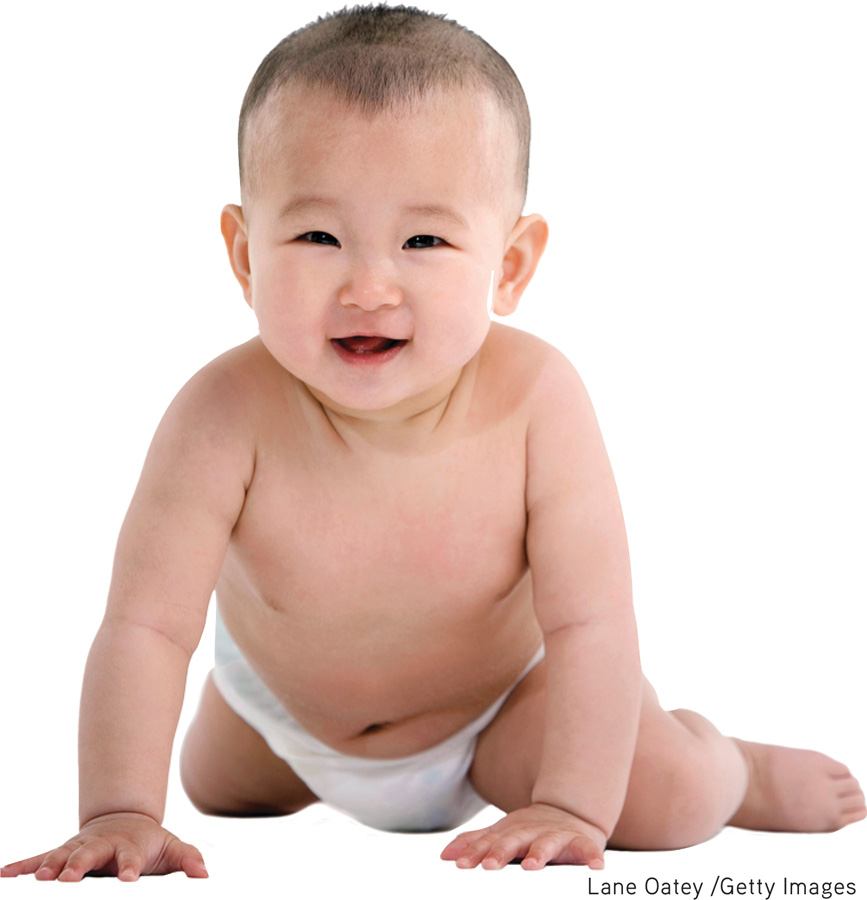
experiment a research method in which an investigator manipulates one or more factors (independent variables) to observe the effect on some behavior or mental process (the dependent variable). By random assignment of participants, the experimenter aims to control other relevant factors.
What do such findings mean? Do smarter mothers have smarter children? (Breast-
experimental group in an experiment, the group exposed to the treatment, that is, to one version of the independent variable.
control group in an experiment, the group not exposed to the treatment; contrasts with the experimental group and serves as a comparison for evaluating the effect of the treatment.
random assignment assigning participants to experimental and control groups by chance, thus minimizing preexisting differences between the different groups.
36
Recall that in a well-done survey, random sampling is important. In an experiment, random assignment is equally important.
To experiment with breast feeding, one research team randomly assigned some 17,000 Belarus newborns and their mothers either to a control group given normal pediatric care, or an experimental group that promoted breast feeding, thus increasing expectant mothers’ breast intentions (Kramer et al., 2008). At three months of age, 43 percent of the infants in the experimental group were being exclusively breast-
With parental permission, one British research team directly experimented with breast milk. They randomly assigned 424 hospitalized premature infants either to formula feedings or to breast-
No single experiment is conclusive, of course. But randomly assigning participants to one feeding group or the other effectively eliminated all factors except nutrition. This supported the conclusion that for developing intelligence, breast is indeed best. If test performance changes when we vary infant nutrition, then we infer that nutrition matters.
The point to remember: Unlike correlational studies, which uncover naturally occurring relationships, an experiment manipulates a factor to determine its effect.
Consider, then, how we might assess therapeutic interventions. Our tendency to seek new remedies when we are ill or emotionally down can produce misleading testimonies. If three days into a cold we start taking vitamin C tablets and find our cold symptoms lessening, we may credit the pills rather than the cold naturally subsiding. In the 1700s, bloodletting seemed effective. People sometimes improved after the treatment; when they didn’t, the practitioner inferred the disease was too advanced to be reversed. So, whether or not a remedy is truly effective, enthusiastic users will probably endorse it. To determine its effect, we must control for other factors.
double-blind procedure an experimental procedure in which both the research participants and the research staff are ignorant (blind) about whether the research participants have received the treatment or a placebo. Commonly used in drug-evaluation studies.
And that is precisely how new drugs and new methods of psychological therapy are evaluated (Chapter 16). Investigators randomly assign participants in these studies to research groups. One group receives a treatment (such as a medication). The other group receives a pseudotreatment—
placebo effect [pluh-SEE-bo; Latin for “I shall please”] experimental results caused by expectations alone; any effect on behavior caused by the administration of an inert substance or condition, which the recipient assumes is an active agent.
In double-
37
RETRIEVAL PRACTICE
- What measures do researchers use to prevent the placebo effect from confusing their results?
Research designed to prevent the placebo effect randomly assigns participants to an experimental group (which receives the real treatment) or to a control group (which receives a placebo). A comparison of the results will demonstrate whether the real treatment produces better results than belief in that treatment.
independent variable in an experiment, the factor that is manipulated; the variable whose effect is being studied.
confounding variable in an experiment, a factor other than the independent variable that might produce an effect.
dependent variable in an experiment, the outcome that is measured; the variable that may change when the independent variable is manipulated.
Independent and Dependent Variables
Here is an even more potent example: The drug Viagra was approved for use after 21 clinical trials. One trial was an experiment in which researchers randomly assigned 329 men with erectile disorder to either an experimental group (Viagra takers) or a control group (placebo takers given an identical-
This simple experiment manipulated just one factor: the drug dosage (none versus peak dose). We call this experimental factor the independent variable because we can vary it independently of other factors, such as the men’s age, weight, and personality. Other factors, which can potentially influence the results of the experiment, are called confounding variables. Random assignment controls for possible confounding variables.
Experiments examine the effect of one or more independent variables on some measurable behavior, called the dependent variable because it can vary depending on what takes place during the experiment. Both variables are given precise operational definitions, which specify the procedures that manipulate the independent variable (the precise drug dosage and timing in this study) or measure the dependent variable (the questions that assessed the men’s responses). These definitions answer the “What do you mean?” question with a level of precision that enables others to repeat the study. (See FIGURE 1.6 for the British breast milk experiment’s design.)
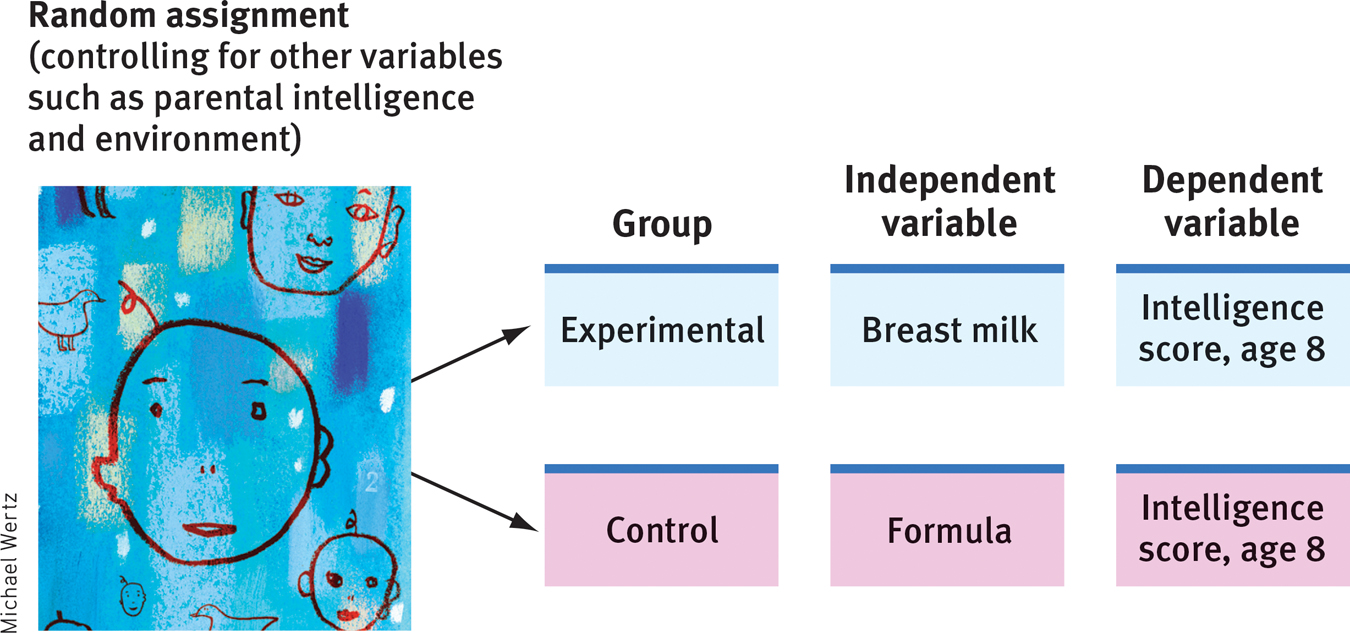
 Figure 1.6
Figure 1.6Experimentation To discern causation, psychologists may randomly assign some participants to an experimental group, others to a control group. Measuring the dependent variable (intelligence score in later childhood) will determine the effect of the independent variable (type of milk).
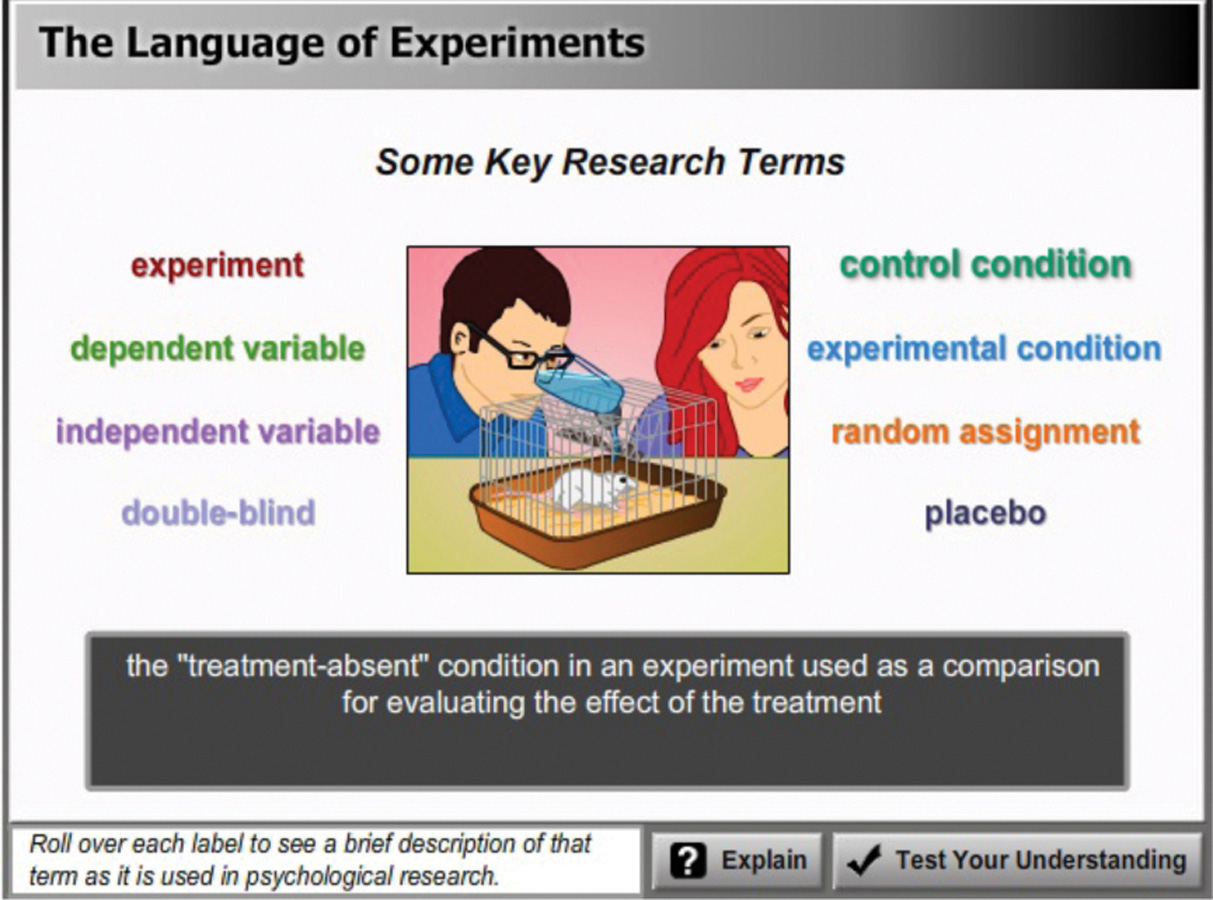
 To review and test your understanding of experimental methods and concepts, visit LaunchPad’s Concept Practice: The Language of Experiments, and the interactive PsychSim 6: Understanding Psychological Research.
To review and test your understanding of experimental methods and concepts, visit LaunchPad’s Concept Practice: The Language of Experiments, and the interactive PsychSim 6: Understanding Psychological Research.
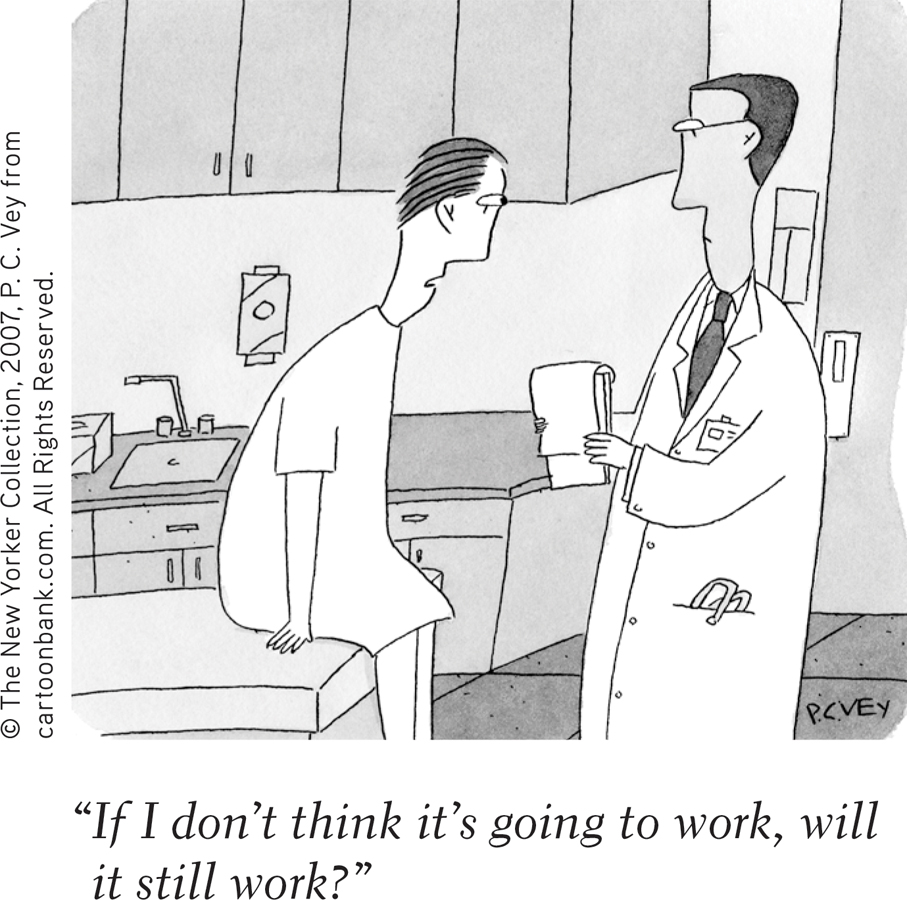
Let’s pause to check your understanding using a simple psychology experiment: To test the effect of perceived ethnicity on the availability of a rental house, Adrian Carpusor and William Loges (2006) sent identically worded e-
Experiments can also help us evaluate social programs. Do early childhood education programs boost impoverished children’s chances for success? What are the effects of different antismoking campaigns? Do school sex-
38
Let’s recap. A variable is anything that can vary (infant nutrition, intelligence, TV exposure—

 Table 1.3
Table 1.3Comparing Research Methods
RETRIEVAL PRACTICE
- In the rental housing experiment, what was the independent variable? The dependent variable?
The independent variable, which the researchers manipulated, was the set of ethnically distinct names. The dependent variable, which they measured, was the positive response rate.
- By using random assignment, researchers are able to control for ______________ ______________, which are other factors besides the independent variable(s) that may influence research results.
confounding variables
- Match the term on the left with the description on the right.
1. double-blind procedurea. helps researchers generalize
from a small set of survey responses
to a larger population
2. random samplingb. helps minimize preexisting
differences between experimental
and control groups
3. random assignmentc. controls for the placebo
effect; neither researchers nor
participants know who receives
the real treatment
1. c, 2. a, 3. b
- Why, when testing a new drug to control blood pressure, would we learn more about its effectiveness from giving it to half of the participants in a group of 1000 than to all 1000 participants?
We learn more about the drug’s effectiveness when we can compare the results of those who took the drug (the experimental group) with the results of those who did not (the control group). If we gave the drug to all 1000 participants, we would have no way of knowing whether the drug is serving as a placebo or is actually medically effective.
39
Predicting Real Behavior
1-
When you see or hear about psychological research, do you ever wonder whether people’s behavior in the lab will predict their behavior in real life? Does detecting the blink of a faint red light in a dark room say anything useful about flying a plane at night? After viewing a violent, sexually explicit film, does an aroused man’s increased willingness to push buttons that he thinks will electrically shock a woman really say anything about whether violent pornography makes a man more likely to abuse a woman?
Before you answer, consider: The experimenter intends the laboratory environment to be a simplified reality—
An experiment’s purpose is not to re-
When psychologists apply laboratory research on aggression to actual violence, they are applying theoretical principles of aggressive behavior, principles they have refined through many experiments. Similarly, it is the principles of the visual system, developed from experiments in artificial settings (such as looking at red lights in the dark), that researchers apply to more complex behaviors such as night flying. And many investigations show that principles derived in the laboratory do typically generalize to the everyday world (Anderson et al., 1999).
The point to remember: Psychological science focuses less on particular behaviors than on seeking general principles that help explain many behaviors.
Psychology’s Research Ethics
1-
We have reflected on how a scientific approach can restrain biases. We have seen how case studies, naturalistic observations, and surveys help us describe behavior. We have also noted that correlational studies assess the association between two factors, which indicates how well one thing predicts another. We have examined the logic that underlies experiments, which use control conditions and random assignment of participants to isolate the effects of an independent variable on a dependent variable.
Yet, even knowing this much, you may still be approaching psychology with a mixture of curiosity and apprehension. So before we plunge in, let’s entertain some common questions about psychology’s ethics and values.
Protecting Research Participants
Studying and protecting animals. Many psychologists study animals because they find them fascinating. They want to understand how different species learn, think, and behave. Psychologists also study animals to learn about people. We humans are not like animals; we are animals, sharing a common biology. Animal experiments have therefore led to treatments for human diseases—
“Rats are very similar to humans except that they are not stupid enough to purchase lottery tickets.”
Dave Barry, July 2, 2002
Humans are complex. But the same processes by which we learn are present in rats, monkeys, and even sea slugs. The simplicity of the sea slug’s nervous system is precisely what makes it so revealing of the neural mechanisms of learning.
40
Sharing such similarities, should we not respect our animal relatives? The animal protection movement protests the use of animals in psychological, biological, and medical research. “We cannot defend our scientific work with animals on the basis of the similarities between them and ourselves and then defend it morally on the basis of differences,” noted Roger Ulrich (1991).
Out of this heated debate, two issues emerge. The basic one is whether it is right to place the well-
Please do not forget those of us who suffer from incurable diseases or disabilities who hope for a cure through research that requires the use of animals.”
Psychologist Dennis Feeney (1987)
If we give human life first priority, what safeguards should protect the well-
“The greatness of a nation can be judged by the way its animals are treated.”
Mahatma Gandhi, 1869–1948
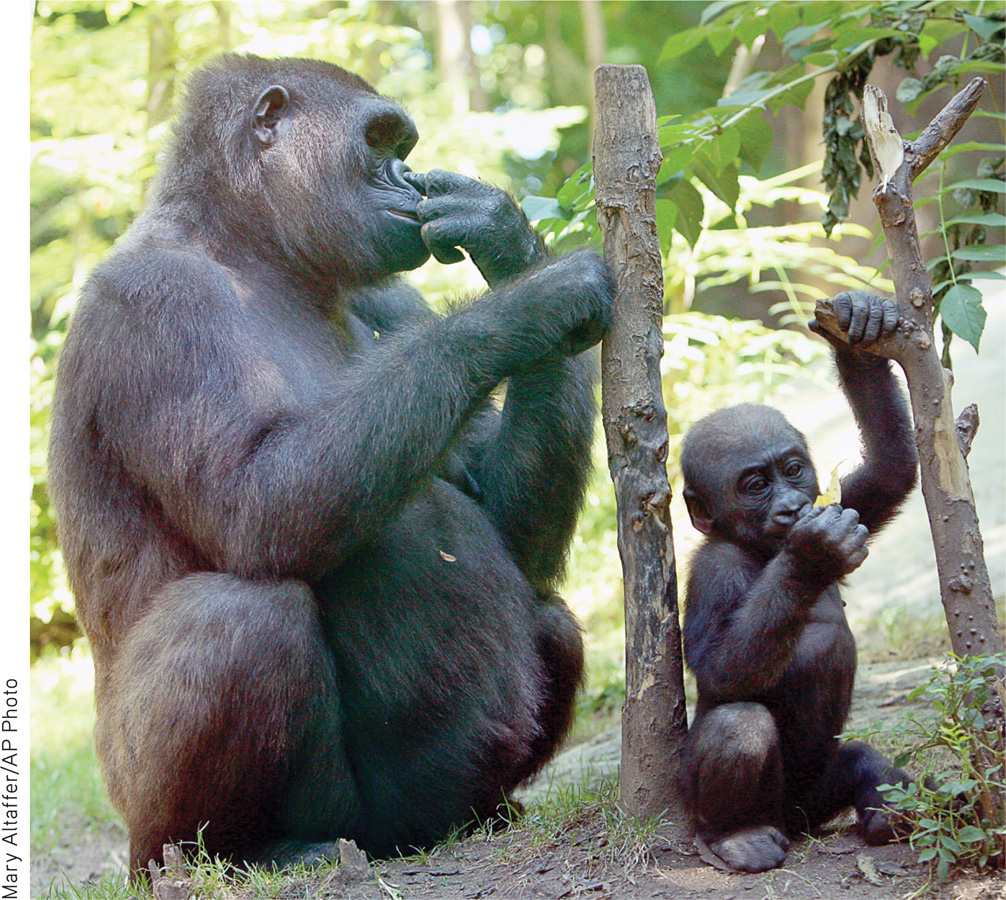
Animals have themselves benefited from animal research. One Ohio team of research psychologists measured stress hormone levels in samples of millions of dogs brought each year to animal shelters. They devised handling and stroking methods to reduce stress and ease the dogs’ transition to adoptive homes (Tuber et al., 1999). Other studies have helped improve care and management in animals’ natural habitats. By revealing our behavioral kinship with animals and the remarkable intelligence of chimpanzees, gorillas, and other animals, experiments have also led to increased empathy and protection for them. At its best, a psychology concerned for humans and sensitive to animals serves the welfare of both.
Studying and protecting humans. What about human participants? Does the image of white-
Occasionally, though, researchers do temporarily stress or deceive people, but only when they believe it is essential to a justifiable end, such as understanding and controlling violent behavior or studying mood swings. Some experiments won’t work if participants know everything beforehand. (Wanting to be helpful, the participants might try to confirm the researcher’s predictions.)
informed consent giving potential participants enough information about a study to enable them to choose whether they wish to participate.
The ethics codes of the APA and Britain’s BPS urge researchers to (1) obtain potential participants’ informed consent before the experiment, (2) protect them from harm and discomfort, (3) keep information about individual participants confidential, and (4) fully debrief people (explain the research afterward). University ethics committees use these guidelines to screen research proposals and safeguard participants’ well-
debriefing the postexperimental explanation of a study, including its purpose and any deceptions, to its participants.
41
Values in Research
Psychology is not value free. Values affect what we study, how we study it, and how we interpret results. Researchers’ values influence their choice of topics. Should we study worker productivity or worker morale? Sex discrimination or gender differences? Conformity or independence? Values can also color “the facts.” As we noted earlier, our preconceptions can bias our observations and interpretations; sometimes we see what we want or expect to see (FIGURE 1.7).
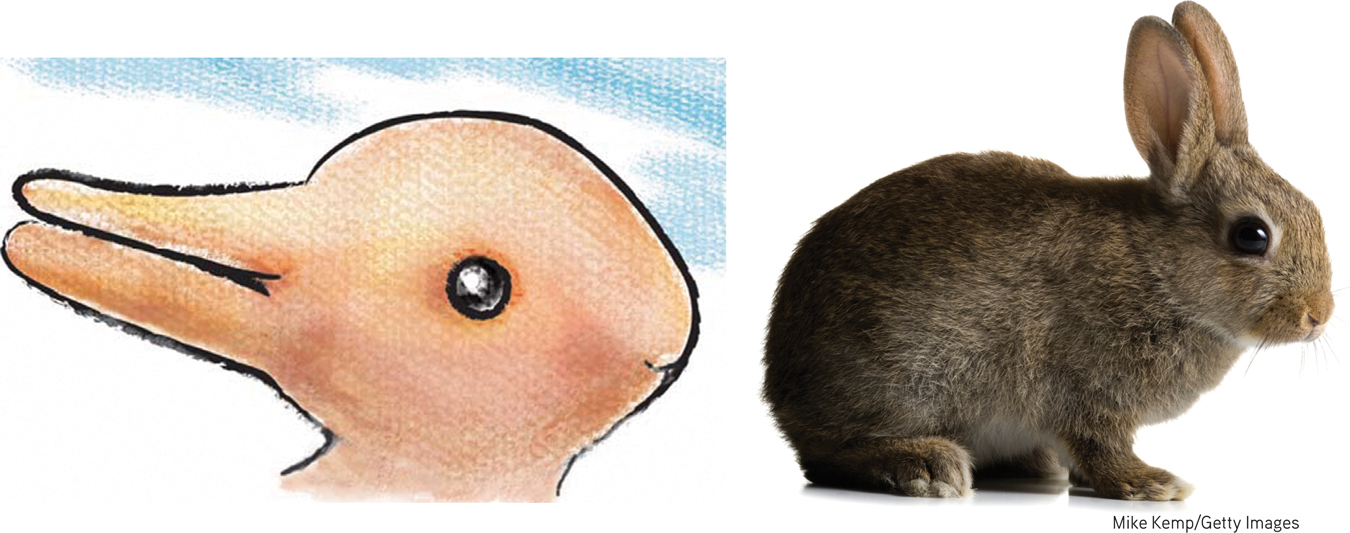
 Figure 1.7
Figure 1.7What do you see? Our expectations influence what we perceive. Did you see a duck or a rabbit? Show some friends this image with the rabbit photo covered up and see if they are more likely to perceive a duck instead. (Inspired by Shepard, 1990.)
Even the words we use to describe something can reflect our values. Are the sex acts we do not practice perversions or sexual variations? In psychology and in everyday speech, labels describe and labels evaluate: One person’s rigidity is another’s consistency. One person’s faith is another’s fanaticism. One country’s enhanced interrogation techniques, such as cold-
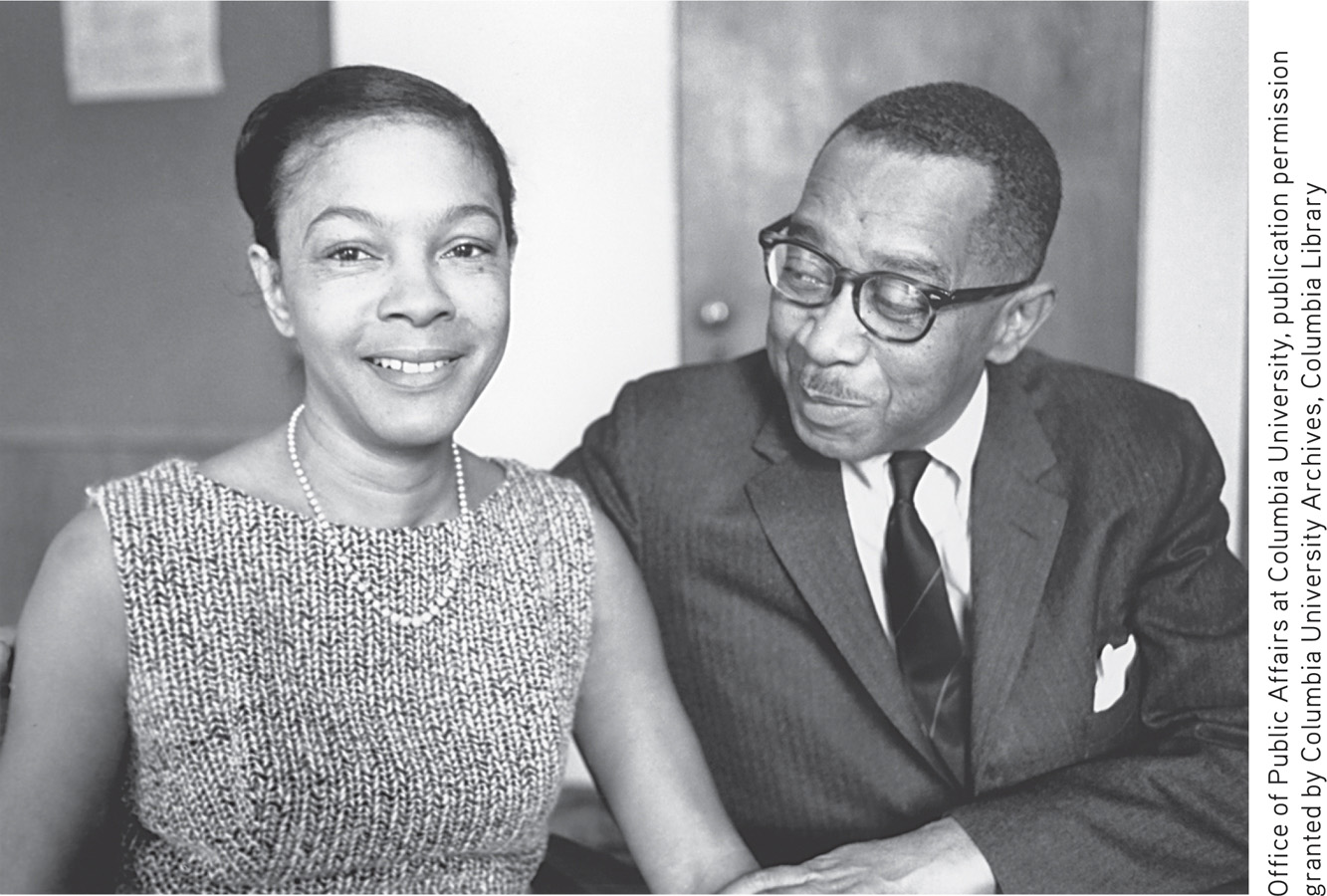
Popular applications of psychology also contain hidden values. If you defer to “professional” guidance about how to live—
If some people see psychology as merely common sense, others have a different concern—
Knowledge, like all power, can be used for good or evil. Nuclear power has been used to light up cities—
42
RETRIEVAL PRACTICE
- How are animal and human research participants protected?
Animal protection legislation, laboratory regulation and inspection, and local ethics committees serve to protect animal and human welfare. At universities, Institutional Review Boards screen research proposals. Ethical principles developed by international psychological organizations urge researchers using human participants to obtain informed consent, to protect them from harm and discomfort, to treat their personal information confidentially, and to fully debrief all participants.
REVIEW: Research Strategies: How Psychologists Ask and Answer Questions

|
REVIEW | Research Strategies: How Psychologists Ask and Answer Questions |
LEARNING OBJECTIVES
RETRIEVAL PRACTICE Take a moment to answer each of these Learning Objective Questions (repeated here from within this section). Then click the 'show answer' button to check your answers. Research suggests that trying to answer these questions on your own will improve your long-
1-
Psychological theories are explanations that apply an integrated set of principles to organize observations and generate hypotheses—predictions that can be used to check the theory or produce practical applications of it. By testing their hypotheses, researchers can confirm, reject, or revise their theories. To enable other researchers to replicate the studies, researchers report them using precise operational definitions of their procedures and concepts. If others achieve similar results, confidence in the conclusion will be greater.
1-
Descriptive methods, which include case studies, naturalistic observations, and surveys, show us what can happen, and they may offer ideas for further study. The best basis for generalizing about a population is a representative sample; in a random sample, every person in the entire population being studied has an equal chance of participating. Descriptive methods cannot show cause and effect because researchers cannot control variables.
1-
When we say two things are correlated, we are saying that they accompany each other in their movements. In a positive correlation, two factors increase or decrease together. In a negative correlation, one item increases as the other decreases. The strength of their relationship is expressed as a correlation coefficient, which ranges from +1.00 (a perfect positive correlation) through 0 (no correlation) to −1.00 (a perfect negative correlation). Their relationship may be displayed in a scatterplot, in which each dot represents a value for the two variables.
1-
Regression toward the mean is the tendency for extreme or unusual scores to fall back toward their average.
1-
Correlations enable prediction because they show how two factors move together, either positively or negatively. A correlation can indicate the possibility of a cause-effect relationship, but it does not prove the direction of the influence, or whether an underlying third factor may explain the correlation.
1-
To discover cause-effect relationships, psychologists conduct experiments, manipulating one or more factors of interest and controlling other factors. Using random assignment, they can minimize confounding variables, such as preexisting differences between the experimental group (exposed to the treatment) and the control group (given a placebo or different version of the treatment). The independent variable is the factor the experimenter manipulates to study its effect; the dependent variable is the factor the experimenter measures to discover any changes occurring in response to the manipulations. Studies may use a double-blind procedure to avoid the placebo effect.
1-
Researchers intentionally create a controlled, artificial environment in the laboratory in order to test general theoretical principles. These general principles help explain everyday behaviors.
1-
Some psychologists are primarily interested in animal behavior; others want to better understand the physiological and psychological processes shared by humans and other species. Government agencies have established standards for animal care and housing. Professional associations and funding agencies also establish guidelines for protecting animals’ well-being. The APA ethics code outlines standards for safeguarding human participants’ well-being, including obtaining their informed consent and debriefing them later.
Psychologists’ values influence their choice of research topics, their theories and observations, their labels for behavior, and their professional advice. Applications of psychology’s principles have been used mainly in the service of humanity.
TERMS AND CONCEPTS TO REMEMBER
RETRIEVAL PRACTICE Match each of the terms on the left with its definition on the right. Click on the term first and then click on the matching definition. As you match them correctly they will move to the bottom of the activity.
Question
theory hypothesis operational definition replication case study naturalistic observation survey population random sample correlation correlation coefficient scatterplot regression toward the mean experiment experimental group control group random assignment double-blind procedure placebo [pluh-SEE-bo] effect independent variable confounding variable dependent variable informed consent debriefing | assigning participants to experimental and control groups by chance, thus minimizing preexisting differences between the different groups. a graphed cluster of dots, each of which represents the values of two variables. The slope of the points suggests the direction of the relationship between the two variables. The amount of scatter suggests the strength of the correlation (little scatter indicates high correlation). in an experiment, the factor that is manipulated; the variable whose effect is being studied. a measure of the extent to which two factors vary together, and thus of how well either factor predicts the other. a statistical index of the relationship between two things (from −1.00 to +1.00). in an experiment, the outcome that is measured; the variable that may change when the independent variable is manipulated. in an experiment, the group not exposed to the treatment; contrasts with the experimental group and serves as a comparison for evaluating the effect of the treatment. a sample that fairly represents a population because each member has an equal chance of inclusion. a descriptive technique for obtaining the self-reported attitudes or behaviors of a particular group, usually by questioning a representative, random sample of the group. repeating the essence of a research study, usually with different participants in different situations, to see whether the basic finding extends to other participants and circumstances. a testable prediction, often implied by a theory. a descriptive technique in which one individual or group is studied in depth in the hope of revealing universal principles. an explanation using an integrated set of principles that organizes observations and predicts behaviors or events. a research method in which an investigator manipulates one or more factors (independent variables) to observe the effect on some behavior or mental process (the dependent variable). By random assignment of participants, the experimenter aims to control other relevant factors. the postexperimental explanation of a study, including its purpose and any deceptions, to its participants. an experimental procedure in which both the research participants and the research staff are ignorant (blind) about whether the research participants have received the treatment or a placebo. Commonly used in drug-evaluation studies. in an experiment, a factor other than the independent variable that might produce an effect. in an experiment, the group exposed to the treatment, that is, to one version of the independent variable. giving potential participants enough information about a study to enable them to choose whether they wish to participate. a descriptive technique of observing and recording behavior in naturally occurring situations without trying to manipulate and control the situation. [pluh-SEE-bo; Latin for “I shall please”] experimental results caused by expectations alone; any effect on behavior caused by the administration of an inert substance or condition, which the recipient assumes is an active agent. a carefully worded statement of the exact procedures (operations) used in a research study. For example, human intelligence may be operationally defined as what an intelligence test measures. all those in a group being studied, from which samples may be drawn. (Note: Except for national studies, this does not refer to a country’s whole population.) the tendency for extreme or unusual scores or events to fall back (regress) toward the average. |
Use  to create your personalized study plan, which will direct you to the resources that will help you most in
to create your personalized study plan, which will direct you to the resources that will help you most in  .
.